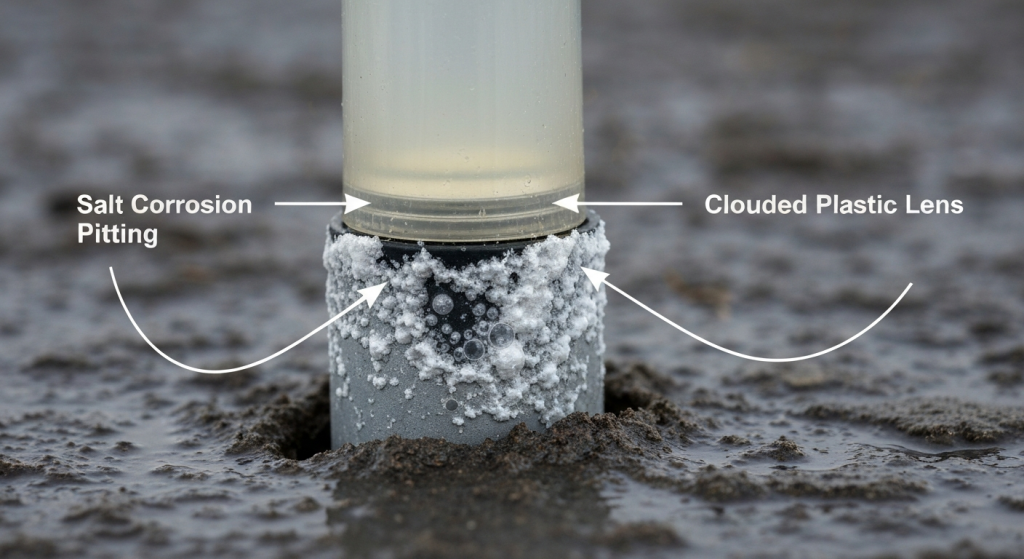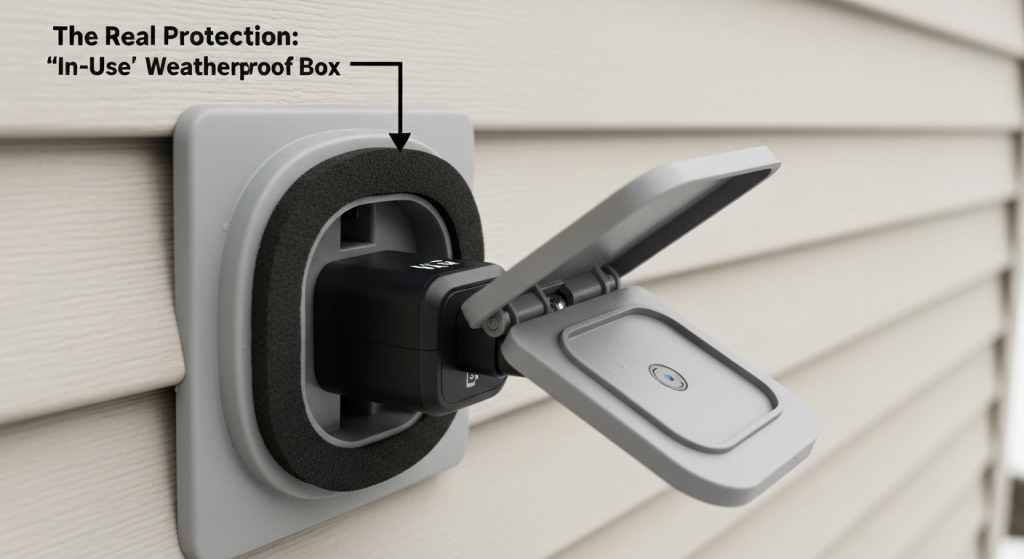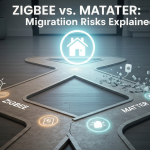That “weatherproof” label on the box feels pretty good in September, doesn’t it? I know the feeling. You buy a new smart camera or outdoor plug, see that “IP65 Rated” stamp, and imagine it bravely handling whatever winter throws at it.
Then, February happens.
After a particularly brutal ice storm, you find your high-tech security camera is offline. Or the smart plug controlling your holiday lights just… gives up. You’re left wondering: What does “weatherproof” even mean? This gap between the marketing claim and the frozen reality is what drives me nuts. I’ve seen too many promising gadgets fail when the temperature plummets and the salt spray kicks in.
So, I decided to stop trusting the labels and start paying attention to what actually survives. This isn’t a sterile lab test. This is my real-world journal of what happened to my outdoor smart devices after one long, harsh winter. I’m sharing what I learned—the good, the bad, and the corroded—so you can make smarter choices for your own home.
Hi, I’m Mahnoor Farooq. For the past few years, I’ve been completely immersed in the world of smart home automation. My passion is figuring out how this technology works in real-world, everyday life, not just in a perfectly controlled lab. I spend my time digging into the research, learning from my own trial-and-error, and finding the best ways to explain it all to readers. After dealing with too many “weather-resistant” failures, I’ve become focused on finding out what truly makes a smart device tough enough for a harsh climate.
What Do Those IP Ratings Really Mean for Winter?
Before I share my results, let’s talk about that IP rating. It’s the first thing most of us look for. You’ll usually see something like IP65.
- The first number (6) is for solids. A ‘6’ is great! It means the device is “dust-tight.” No dust, dirt, or snow can get in.
- The second number (5) is for liquids. A ‘5’ means it’s protected from water jets from any direction. Think of a heavy rainstorm or a spray from your garden hose.
Here’s the thing: IP ratings are tested in a controlled lab. These tests do not account for the three biggest enemies of winter electronics:
- Freeze-Thaw Cycles: This is the real killer. Water or condensation gets into a microscopic crack. At night, it freezes and expands, making the crack bigger. The next day, it melts. The next night, it freezes again. After a few weeks of this, that tiny crack is now a gaping hole, and your device’s delicate circuits are exposed.
- Ice Encasement: The IP test checks for liquid water. It doesn’t check what happens when the entire device is encased in a solid block of ice for a week. This puts physical stress on seals and casings that “water-jet” tests miss.
- Corrosion (Salt): This is the silent destroyer, especially for coastal residents or anyone near a heavily salted road. The IP rating tells you nothing about a material’s ability to resist the corrosive power of salt spray, which eats away at metal casings and connection points.
I learned the hard way that an IP67-rated device (which can supposedly be submerged in water) can still fail a hard winter while a “lesser” IP64 device survives. It all comes down to placement and materials.
My Winter “Testing Ground”: The Conditions
To give you some context, my home gets the full winter experience. I’m far enough north to see temperatures dip well below zero, but I’m also close enough to major roads (and the coast) to deal with a constant, fine mist of corrosive salt spray.
This past winter, my outdoor smart devices had to endure:
- Deep Freeze: Several nights between -5°F and -10°F (-20°C to -23°C).
- Temperature Swings: Wild fluctuations, sometimes going from 10°F to 45°F and back again in 48 hours. This is prime freeze-thaw territory.
- Ice Storms: At least two major events that left everything coated in a 1/4-inch-thick layer of ice.
- Heavy, Wet Snow: The kind of snow that’s more water than fluff. It’s heavy and piles up, burying ground-level devices.
- Salt Spray: A constant airborne menace from nearby roads being treated.
I didn’t do anything special to these devices. I just installed them where I needed them and let nature do its worst.
The Contenders: What I Tested (and Where I Put It)
I had three main categories of devices in my “test.” I’m not naming brands because I found the type of device and where I put it mattered more than the brand itself.
Smart Plugs: The Exposed Workers
I had two outdoor smart plugs, both rated IP64. This rating means they’re dust-tight (6) but only protected from splashes of water (4), not jets.
- Placement: One was in a “weather-resistant” outlet cover on my deck, controlling string lights. The other was more exposed, plugged into an outlet on the side of my garage for holiday decorations.
Smart Security Cameras: The Frozen Watchmen
This was a mixed bag. I had two cameras installed.
- Camera 1 (IP65): Placed in a very common spot—under the eave of my roof, overlooking the driveway. It was mostly protected from direct rain and snow but fully exposed to the cold air and salt spray.
- Camera 2 (IP67): I put this one in a truly terrible spot on purpose. It was mounted on a fence post, completely exposed to every element: sun, wind, rain, and ice. The IP67 rating meant it should be the toughest of the bunch.
Smart Pathway Lights: The Ground-Level Victims
I have a set of six smart pathway lights, all IP65, lining my front walk.
- Placement: Right in the splash-zone from the snowplow and directly in the path of where I shovel. They spent most of January and February completely buried under snow drifts.
The Winter Post-Mortem: Real-World Durability Results
Spring finally arrived, and I did a full audit. The results were genuinely surprising and taught me a lot.
The Smart Plugs (IP64): Surprising Survivors
Result: Both Survived.
I was shocked by this. The plug on my deck was encased in ice for weeks. I was certain it was dead. But when things thawed, it reconnected to my Wi-Fi and worked perfectly.
My Takeaway: The key wasn’t the “4” in its IP64 rating. It was the physical weatherproof outlet box it was mounted in. The foam gasket on the box cover created a tight seal. When that froze, it stayed sealed. The plug itself was never exposed. The lesson here is that an IP64 plug plus a good-quality weatherproof box is a rock-solid combination.
The Smart Cameras: A Tale of Two Fates

This is where it gets interesting.
Camera 1 (IP65, Under Eave): Survived.
This camera performed like a champ. Being tucked under the eave saved it. It never got directly encased in ice, and snow couldn’t pile on top of it. The wind-driven salt spray hit it, but the plastic housing seems to have held up.
Camera 2 (IP67, Exposed Post): Failed.
This is my favorite example. The “tougher” IP67 camera died in early March. It just went offline and never came back. When I took it down, I could see moisture inside the lens.
My Takeaway: The IP67 rating (for submersion) was useless. The constant freeze-thaw cycles on that exposed fence post were too much. A seal must have been compromised, letting in a tiny bit of moisture during a daytime melt. That night, it froze, expanded, and destroyed the electronics. This proved my theory: Placement beats IP rating every time. An IP65 camera in a sheltered spot is infinitely better than an IP67 camera taking a direct hit.
The Pathway Lights (IP65): The Salt Spray Disaster

Result: Technically Survived… but They’re Destroyed.
This was the saddest result. When the snow melted, all six lights still turned on. But they looked awful.
- Corrosion: The “powder-coated” aluminum stakes and housings were pitted, bubbled, and covered in a white, chalky residue. The salt had eaten right through the finish.
- Cloudy Lenses: The plastic lenses were no longer clear. They were hazy and brittle, likely from a combination of UV damage, salt, and temperature swings.
My Takeaway: This is the coastal problem in a nutshell. The IP65 rating kept water out of the electronics (good!), but it said nothing about the materials. The salt spray, combined with being buried in wet, salty snow, annihilated the exterior. They work, but they’re an eyesore and I doubt the lenses will last another year.
My “On-the-Ground” Durability Notes
I put together this table from my personal notes. It’s not a formal lab report; it’s just what I saw. This really highlights the gap between a rating and the reality of a harsh winter.
| Device / Claimed Rating | The Lab Test (What the IP Rating Means) | My Real-World Winter Experience |
| Smart Plug (IP64) | “Dust-tight” and safe from “splashes.” | Passed. But its survival was 100% due to being inside a high-quality weatherproof outlet box. |
| Camera (IP65, Eaves) | “Dust-tight” and safe from “water jets.” | Passed. The eave protected it from direct ice and snow buildup. Location was the key. |
| Camera (IP67, Exposed) | “Dust-tight” and safe from “submersion (1m).” | Failed. Constant freeze-thaw cycles on the exposed housing compromised a seal. Moisture got in and killed it. |
| Pathway Lights (IP65) | “Dust-tight” and safe from “water jets.” | Partial Fail. The electronics survived, but the metal casings and plastic lenses were ruined by salt corrosion and ice. |
How to Actually Weatherproof Your Smart Home for Snow and Salt

After this experience, I’ve changed my entire approach. I now ignore marketing hype and follow a few simple, experience-based rules.
1. Location and Physical Protection Are Your First Priority
This is my number one rule. An overhang, porch ceiling, or eave is the best weatherproofing you can get.
- Cameras: Mount them under eaves. Never on an exposed wall or post if you can help it.
- Plugs: Only use them inside a certified “in-use” weatherproof outlet cover. These are the deep covers that let you seal the box while a cord is plugged in.
- Lights: Avoid ground-level placement in areas that get heavy snow drifts or (if you’re in a coastal area) a lot of salt spray.
2. Create a “Second Skin” for Vulnerable Spots
For any device that must be exposed, I add my own layer of protection.
- Dielectric Grease: This is a non-conductive, waterproof grease. Before winter, I now unplug my pathway lights and put a small dab of this grease on the electrical contacts. It’s brilliant at stopping moisture and corrosion from getting into the most sensitive part.
- Silicone Caulk: For camera mounts, I run a small, neat bead of clear outdoor silicone caulk around the base of the mount where it meets the wall. This stops water from seeping behind the mount and into the wall or the cable entry.
- Marine-Grade Materials: This is my new obsession for coastal areas. If you’re buying new, look for materials like brass, marine-grade (316) stainless steel, or thick, UV-stabilized ABS plastic. They cost more, but they won’t look like garbage after one winter. For more technical details on enclosure types, the official IEC guidelines offer a good starting point, but remember they don’t test for salt.
3. Check the Other Specs: Temperature and Power
Two things are often overlooked but are just as important as the IP rating.
- Operating Temperature Range: Dig into the product’s spec sheet. Many smart devices have a low-end limit of -4°F (-20°C). If you live somewhere that regularly gets colder, that device is likely to fail, no matter its IP rating.
- Battery vs. Wired: Extreme cold kills batteries. Any battery-powered smart device (like some cameras or smart locks) will see its battery life plummet in a deep freeze. For critical devices like cameras, I will always choose a wired option if possible. It’s just more reliable when the temperature drops.
Frequently Asked Questions (FAQs)
Can I just put my smart plug in a plastic Ziploc bag?
Please don’t. I’ve seen people try this, and it’s a terrible idea. A plastic bag traps condensation. Moisture from the air will get in, and then it can’t get out. You’re creating a tiny greenhouse that will fill with water and short your plug. Use a proper, ventilated “in-use” weatherproof outlet cover.
Is IP67 always better than IP65 for winter?
As my test showed, no. IP67 means it can be dunked in a meter of water. That doesn’t help at all against ice expansion or salt corrosion. I would much rather have a well-placed IP65 device under an eave than an exposed IP67 device on a post.
What’s the most common failure point you’ve seen?
Hands down, it’s the seals. Rubber and plastic seals get brittle in the extreme cold. The freeze-thaw cycle then pops them open just enough for moisture to creep in. This is especially true on lenses and where power cables enter the device.
What about smart locks in the cold?
Smart locks are tricky. The main risk isn’t water (they are usually well-protected by the door), but the cold itself. First, the battery life can drop fast. Second, the physical mechanism can freeze. I only use smart locks that also have a physical key backup. I need to know I can always get in, even if the electronics fail.
My Final Thoughts on Winter-Proofing
After this winter, my biggest lesson is to be a skeptic. That “weatherproof” label is a starting point, not a guarantee. Real-world winter durability has less to do with a lab-tested number and more to do with smart placement, physical protection, and choosing materials that can handle corrosion, not just a spray of water.
Don’t just trust the box. Look at your home, find the sheltered spots, and think about how a device will be attacked by the elements. A little planning before you install will save you a lot of money and frustration come spring.


